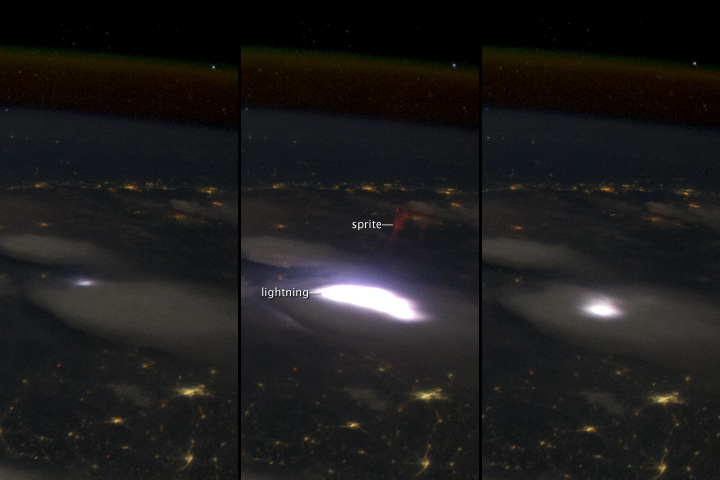click to enlarge the photo:

acquired April 30, 2012
acquired April 30, 2012
download large ISS031-E-10711 image (220 KB, JPEG, 1440x960)
acquired April 30, 2012
download large ISS031-E-10712 image (224 KB, JPEG, 1440x960)
acquired April 30, 2012
download large ISS031-E-10713 image (221 KB, JPEG, 1440x960)
They were once so elusive that
scientists gave them a mystical name. “Red sprites” are short-lived, red
flashes that occur about 80 kilometers (50 miles) up in the atmosphere.
With long, vertical tendrils like a jellyfish, these electrical
discharges can extend 20 to 30 kilometers up into the atmosphere and are
connected to thunderstorms and lightning.
These images of a red sprite were captured with a digital camera by Expedition 31 astronauts on the International Space Station as they traveled southeast from central Myanmar (Burma) to just north of Malaysia. The still images are part of a time-lapse movie collected from 13:41 to 13:47 Universal Time on April 30, 2012. (View the entire sequence here.) The sprite occurs about 6 seconds into the video, above a bright, wide lightning flash in the upper right quadrant.
Red sprites are difficult to observe because they last for just a few milliseconds and occur above thunderstorms—meaning they are usually blocked from view on the ground by the very clouds that produce them. They send pulses of electrical energy up toward the edge of space—the electrically charged layer known as the ionosphere—instead of down to Earth’s surface. They are rich with radio noise, and can sometimes occur in bunches.
For decades, pilots reported seeing ephemeral flashes above storms, but it was not until the 1990s that scientists were able to verify the existence of these electrical discharges. A sprite was first photographed by accident from an airplane in 1989, and observers on the space shuttle captured several more images with low-light cameras in 1990 and in subsequent missions. Viewers on the ground can occasionally photograph sprites by looking out on a thunderstorm in the distance (often looking out from high mountainsides over storms in lower plains.)
These images of a red sprite were captured with a digital camera by Expedition 31 astronauts on the International Space Station as they traveled southeast from central Myanmar (Burma) to just north of Malaysia. The still images are part of a time-lapse movie collected from 13:41 to 13:47 Universal Time on April 30, 2012. (View the entire sequence here.) The sprite occurs about 6 seconds into the video, above a bright, wide lightning flash in the upper right quadrant.
Red sprites are difficult to observe because they last for just a few milliseconds and occur above thunderstorms—meaning they are usually blocked from view on the ground by the very clouds that produce them. They send pulses of electrical energy up toward the edge of space—the electrically charged layer known as the ionosphere—instead of down to Earth’s surface. They are rich with radio noise, and can sometimes occur in bunches.
For decades, pilots reported seeing ephemeral flashes above storms, but it was not until the 1990s that scientists were able to verify the existence of these electrical discharges. A sprite was first photographed by accident from an airplane in 1989, and observers on the space shuttle captured several more images with low-light cameras in 1990 and in subsequent missions. Viewers on the ground can occasionally photograph sprites by looking out on a thunderstorm in the distance (often looking out from high mountainsides over storms in lower plains.)
Related Reading
- NASA Gateway to Astronaut Photography of Earth. (n.d.) Crew Earth Observations Videos—Southeast Asia. Accessed July 9, 2012.
- NASA. (1997). Sprites and Jets. Accessed July 9, 2012.
- Science@NASA. (1999, June 10). Spirits of Another Sort: Thunderstorms Generate Elusive and Mysterious Sprites. Accessed July 9, 2012.
- University of Alaska–Fairbanks. (n.d.) Red Sprites and Blue Jets. Accessed July 9, 2012.
Astronaut photographs ISS031-E-10711, ISS031-E-10712, and ISS031-E-10713 were acquired on April 30, 2012. Additional images taken by astronauts and cosmonauts can be viewed at the NASA/JSC Gateway to Astronaut Photography of Earth. Caption by Michael Carlowicz.
- Instrument:
- ISS - Digital Camera
Ricardo M Marcenaro - Facebook
Operative blogs of The Solitary Dog:
solitary dog sculptor:
http://byricardomarcenaro.blogspot.com
Solitary Dog Sculptor I:
http://byricardomarcenaroi.blogspot.com
Para:
comunicarse conmigo,
enviar materiales para publicar,
propuestas:
marcenaroescultor@gmail.com
For:
contact me,
submit materials for publication,
proposals:
marcenaroescultor@gmail.com
Diario La Nación
Argentina
Cuenta Comentarista en el Foro:
Capiscum
My blogs are an open house to all cultures, religions and countries. Be a follower if you like it, with this action you are building a new culture of tolerance, open mind and heart for peace, love and human respect.
Thanks :)
Mis blogs son una casa abierta a todas las culturas, religiones y países. Se un seguidor si quieres, con esta acción usted está construyendo una nueva cultura de la tolerancia, la mente y el corazón abiertos para la paz, el amor y el respeto humano.
Gracias :)

No hay comentarios:
Publicar un comentario